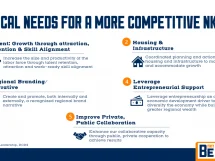
In December 2016, The Wall Street Journal writer Greg Ip drove a compelling argument that innovation’s impact on communities is slow as we craft ideas, noting that the economy was beginning to suffer. His article, “The Economy’s Hidden Problem: We’re Out of Ideas,” challenges us to come up with creative means to help ourselves. He notes that it took 40 years for Edison’s light bulb to really make a difference. Furthermore, despite Bloomberg News’ forecast for a greater annualized growth in 2016, the year ended with the lowest economic growth of the national economy since 2011, with expansion only at 1.9 percent.
Kentucky is changing this trend, however. By looking around the state, we know that innovation is of key importance to Kentucky as investments grow in a variety of industries. In 2016, Kentucky graduated more college students than ever before, with an increase of 32.5 percent over 10 years. With private/public partnerships, Kentuckians are actively creating relationships that are already changing this trend and guess who is helping lead this cause – THE ARTS!
According to the most recent figures from the National Endowment for the Arts and the Bureau of Economic Analysis, arts and cultural production contributed $704.2 billion to the U.S. economy in 2013, a 32.5 percent increase since 1998. Kentucky’s creative industry, which encompasses those who make all or part of their income through their creative work, can be used to elevate innovative thought-leadership in communities. It’s a matter of thinking differently. Artists do this best; it’s in their DNA. Call on the arts!
The term “innovation” replaces the word “change” with the concept of moving forward in more efficient and effective ways that sustain or increase mission. Where does a company or organization start?
Let’s look at education. Artists and arts organizations can help in the reshaping of learning itself. Call on the arts! By injecting innovative thinking into our academic curriculum both in schools and in professional development, we transform STEM (science, technology, engineering and math) to STEAM – science, technology, engineering, arts and math. STEAM educators and human resource trainers can alter focus to include the study of science, technology, engineering, arts and math for application to problem solving. In hoisting the importance of creativity in problem solving for innovation, The Huffington Post touted, “Creativity will always be America’s secret sauce.”
Let’s look at business strategy. Firms self-report that they often feel they do not have the appropriate mix of staff, resources and know-how to operate in this space. Call on the arts!
As companies are encouraged to address the diverse interests of society, they understand the impact of innovation but struggle to find the most effective approach. Below are some how-to steps for using the arts in innovation:
• Enact a social vision. Determine how innovation and community impact could include creative thought.
• Reach out to creatives. Meet arts and creative leaders in your state and invite them to brainstorm and help.
• Train your leaders to embrace creativity. Arts groups and the Kentucky Arts Council have programs for peer learning.
• Recruit talent. Employees want to live and work in a vibrant community.
• Put your organization in the spotlight. Arts help you enhance brand and reach customers.
• Advance corporate objectives. The arts help get your message across in engaging ways.
• Foster critical thinking. One of the most applied skills sought by employers is creativity.
• Engage employees. Arts bring out the best in employees and encourage the happiness factor.
• Build diverse teams. Blending difference in backgrounds, cultures and thoughts always increases impact.
• Contribute to your community. The arts build quality of life and economy, which sustains communities.
Studies show that highly effective leaders are willing to take on the risks of creative innovation because of the often-proven outcomes. Common benefits include:
• Increased trust and reduced transaction costs between parties
• Profit/margin increase
• Product diversification and entry into new markets
• Customer fidelity and customer satisfaction growth
• Market share maintenance or increase
• Better strategic position
• Creation of new business development opportunities
• Forging of relationships with new perspectives, addressing multiple stakeholder interests
• Increased cooperation along chains
• Increase of competitive advantage
• Utilization of economies of scale.
Innovation is active, creative and aimed at breakthroughs. Call on the arts! ■
Lydia Bailey Brown is executive director of the Kentucky Arts Council.




















Add Comment